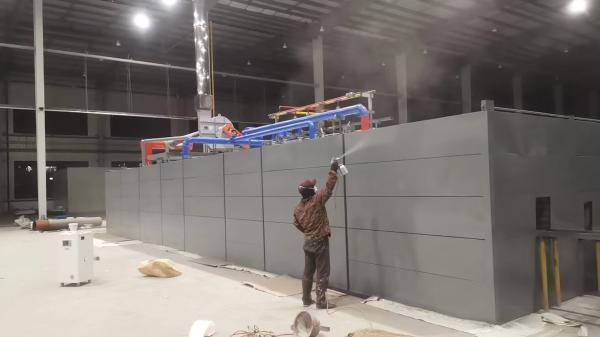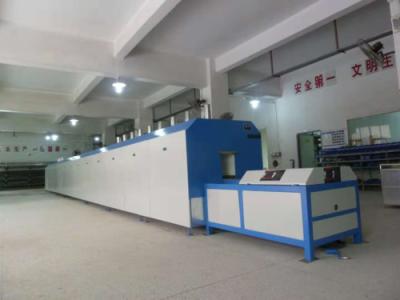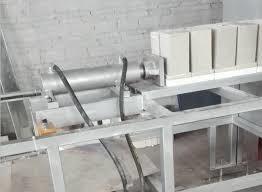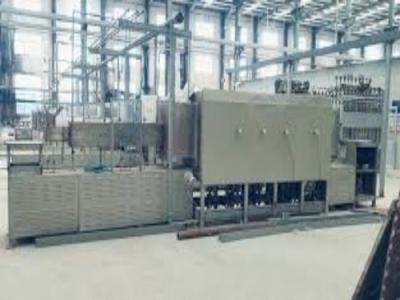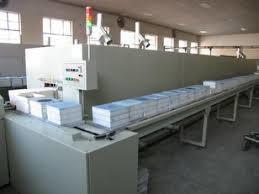Push Plate Kiln for Ceramic Production: High - Efficiency and Precise Firing
1. Brief Overview
The push plate kiln is an essential piece of equipment in modern ceramic production. It belongs to the category of continuous - type furnaces, which are designed to streamline the ceramic firing process.
Structure and Components
The kiln typically consists of several key parts. The loading area is where ceramic products, placed on heat - resistant push plates, are introduced into the kiln. These push plates are usually made of materials such as high - alumina ceramics or silicon carbide, which can withstand the high temperatures inside the kiln. The heating zone is the core of the push plate kiln. It is divided into multiple segments, each equipped with independent heating elements. These elements can be electric resistors, gas burners, or other heating sources, depending on the specific requirements of the ceramic production process. The temperature in each zone can be precisely controlled, allowing for the creation of complex temperature profiles. The unloading area is where the fired ceramic products are removed from the kiln after they have completed the firing cycle.
Working Principle
The operation of the push plate kiln is relatively straightforward. Once the ceramic products are loaded onto the push plates at the loading end, a mechanical pushing mechanism, which can be either hydraulic or pneumatic, moves the push plates forward at a controlled speed. As the push plates travel through the heating zone, the ceramic products are exposed to gradually increasing temperatures. The multi - zone heating system enables the products to experience different temperature stages, which are crucial for various ceramic manufacturing processes, such as dehydration, oxidation, sintering, and glazing. The entire process is continuous, which means that new batches of ceramic products can be loaded into the kiln while previously loaded products are being fired and unloaded, greatly enhancing production efficiency.
Types of Push Plate Kilns
There are different types of push plate kilns available in the market, mainly differentiated by their heating methods and the scale of production they can accommodate. Electric - heated push plate kilns are popular for their clean operation and precise temperature control. They are often used in the production of high - end ceramic products where tight temperature tolerances are required. Gas - fired push plate kilns, on the other hand, are more cost - effective for large - scale production due to the relatively lower cost of gas as an energy source. They can generate high heat outputs, making them suitable for firing large quantities of ceramic products. In terms of size, there are small - scale push plate kilns for laboratory or small - batch production, and large - scale industrial - grade kilns that can handle high - volume production in commercial ceramic manufacturing plants.

2. Features
High Efficiency
The continuous operation of the push plate kiln is its most significant efficiency - enhancing feature. Unlike batch - type kilns, where the entire kiln has to be loaded, fired, and unloaded in a sequential manner, the push plate kiln allows for a continuous flow of products. This means that the production line can keep running without significant interruptions, resulting in a much higher output rate. For example, in a large - scale ceramic tile manufacturing plant, a well - designed push plate kiln can produce thousands of square meters of tiles per day. The automated pushing mechanism also reduces the time and labor required for loading and unloading products, further improving overall efficiency.
Precise Temperature Control
With multiple temperature - controlled zones, the push plate kiln offers unparalleled precision in temperature management. Each zone can be set to a specific temperature, and advanced control systems can maintain these temperatures within a very narrow tolerance range. This is crucial for ceramic production as different stages of the firing process, such as the initial drying stage, the high - temperature sintering stage, and the cooling stage, require different temperature profiles. For instance, during the sintering of porcelain, the temperature needs to be carefully controlled within a few degrees to ensure the proper densification and crystallization of the ceramic material. The precise temperature control also contributes to the consistent quality of the final ceramic products, reducing the occurrence of defects caused by temperature fluctuations.
Energy - Saving Design
Modern push plate kilns are designed with energy - saving in mind. High - quality insulation materials are used to line the kiln walls, minimizing heat loss to the surrounding environment. The heating elements are also selected for their high energy - conversion efficiency. In addition, the optimized firing process, enabled by the precise temperature control and continuous operation, reduces the overall energy consumption per unit of product. For example, compared to older - style batch kilns, a push plate kiln can achieve a 30 - 50% reduction in energy consumption, which is not only beneficial for the environment but also for the long - term operating costs of the ceramic production facility.
Automated Operation
Automation is another key feature of the push plate kiln. The entire firing process, from loading the products onto the push plates to unloading the fired products, can be automated. Sensors are used to monitor the position of the push plates, the temperature in each zone, and other critical parameters. The data collected by these sensors is then used to control the operation of the kiln through a programmable logic controller (PLC) or a computer - based control system. This automated operation not only reduces the labor intensity but also improves the stability and reproducibility of the production process. Operators can set the desired firing parameters once, and the kiln will automatically maintain the correct operating conditions throughout the production run.
3. Applications in Ceramic Production
Ceramic Tile Production
- Body Sintering
-
- In ceramic tile manufacturing, the push plate kiln is first used for sintering the tile body. The raw materials for ceramic tiles, which typically include clay, feldspar, quartz, and other additives, are formed into tile shapes and then placed on the push plates. As the push plates move through the heating zone of the kiln, the tile bodies are gradually heated. In the initial stages, moisture is removed from the tile bodies at relatively low temperatures. Then, as the temperature rises, the chemical reactions start to occur. The clay minerals undergo dehydration and recrystallization, while the feldspar and quartz melt and bind the other components together. The precise temperature control in the push plate kiln ensures that the tile bodies are sintered uniformly, resulting in tiles with consistent strength and density. For example, in the production of porcelain tiles, which are known for their high strength and low water absorption, the sintering temperature in the push plate kiln is carefully maintained between 1200 - 1300°C.
- Glaze Firing
-
- After the body sintering, the tiles are often glazed to enhance their appearance and functionality. The push plate kiln is again used for glaze firing. Glazes are applied to the surface of the pre - sintered tile bodies, and then the tiles are re - introduced into the kiln. The glaze firing process requires a different temperature profile compared to body sintering. The temperature is usually raised to a point where the glaze melts and spreads evenly over the tile surface, forming a smooth and glossy finish. The multi - zone temperature control of the push plate kiln allows for a gentle heating and cooling cycle, which is essential for preventing the formation of cracks or bubbles in the glaze. Different types of glazes, such as glossy, matte, or textured glazes, require specific temperature and time combinations, and the push plate kiln can be easily adjusted to meet these requirements. For example, a glossy glaze may require a peak temperature of around 1000 - 1100°C, while a matte glaze may need a slightly lower temperature and a different cooling rate.
- Specialty Tile Production
-
- In the production of specialty tiles, such as anti - slip tiles or tiles with unique decorative effects, the push plate kiln also plays a crucial role. Anti - slip tiles often require a specific surface texture, which can be achieved by controlling the firing process. The push plate kiln can be used to create a rough surface on the tile body during sintering or to apply a special glaze that provides the anti - slip property. For tiles with decorative effects like in - lay patterns or metallic lusters, the kiln's precise temperature control enables the proper fusion and adhesion of different materials. For instance, tiles with in - lay patterns may require multiple firing steps in the push plate kiln to ensure that the in - lay materials are firmly bonded to the tile body and that the overall appearance is aesthetically pleasing.
Ceramic Tableware Production
- Bisque Firing
-
- Ceramic tableware production begins with bisque firing. The unfired ceramic tableware pieces, made from clay mixtures, are placed on the push plates and sent through the push plate kiln. During bisque firing, the temperature is gradually increased to around 900 - 1000°C. At this temperature, the clay undergoes a series of physical and chemical changes. The water in the clay is completely removed, and the clay particles start to bond together, giving the tableware pieces their initial strength. The bisque - fired tableware is then ready for further processing, such as glazing or decoration. The continuous operation of the push plate kiln allows for a large number of tableware pieces to be bisque - fired in a short time, meeting the high - volume production demands of the tableware industry.
- Glaze Firing and Decoration Firing
-
- After bisque firing, the tableware pieces are glazed. The glaze not only provides a smooth and attractive surface but also makes the tableware more resistant to stains and scratches. The push plate kiln is used for glaze firing, where the temperature is adjusted to melt the glaze and ensure a uniform coating on the tableware. Different types of glazes, such as transparent glazes, colored glazes, or underglaze decorations, require specific firing conditions. For example, underglaze decorations are applied to the bisque - fired surface, and then a transparent glaze is applied on top. The push plate kiln is used to fire the tableware at a temperature that allows the underglaze colors to develop and the transparent glaze to melt and seal the decoration. In some cases, additional firing steps may be required for overglaze decorations, such as applying gold or platinum luster. The push plate kiln's ability to provide precise temperature control and a consistent firing environment is essential for achieving high - quality and durable ceramic tableware.
- Quality Control and Batch Production
-
- In ceramic tableware production, quality control is of utmost importance. The push plate kiln's precise temperature control and automated operation contribute to consistent product quality. Since the kiln can maintain the same firing conditions for each batch of tableware, the likelihood of defects, such as uneven glazing or warping, is significantly reduced. This is especially important for large - scale tableware manufacturers who need to produce thousands of identical pieces for commercial use. The continuous operation of the push plate kiln also allows for efficient batch production. New batches of tableware can be loaded into the kiln as soon as the previous batch has been unloaded, maximizing production output while maintaining quality standards.
Advanced Ceramic Production
- Ceramic for Electronics
-
- In the production of ceramics for electronics, such as ceramic capacitors, resistors, and substrates, the push plate kiln is indispensable. Ceramic capacitors, for example, are made from ceramic materials with specific dielectric properties. The push plate kiln is used to sinter the ceramic powders into the desired capacitor shapes. The precise temperature control is crucial because the dielectric properties of the ceramic are highly sensitive to the firing temperature. A small deviation in temperature can lead to significant changes in the capacitance value of the capacitor. The push plate kiln allows for a controlled heating and cooling process, ensuring that the ceramic capacitors have consistent and accurate electrical properties. Similarly, for ceramic substrates used in printed circuit boards, the push plate kiln is used to sinter the ceramic materials to a high density, providing a stable and electrically insulating base for the electronic components.
- Ceramic for Aerospace and Defense
-
- Advanced ceramics used in aerospace and defense applications, such as ceramic matrix composites and thermal barrier coatings, require extremely precise firing conditions. Ceramic matrix composites are made by embedding ceramic fibers in a ceramic matrix. The push plate kiln is used to sinter the composite materials at high temperatures, typically above 1500°C. The high - temperature resistance and precise temperature control of the push plate kiln enable the proper bonding of the fibers and the matrix, resulting in materials with high strength, low weight, and excellent thermal resistance. Thermal barrier coatings, which are applied to the surfaces of aircraft engine components to protect them from high temperatures, are also processed using push plate kilns. The kiln is used to sinter the coating materials onto the substrate, ensuring a strong adhesion and the desired thermal insulation properties.
- Bioceramics Production
-
- Bioceramics, which are used in medical applications such as dental implants and bone grafts, also rely on the push plate kiln for production. These ceramics need to have specific physical and chemical properties to be biocompatible. The push plate kiln is used to sinter the bioceramic materials, such as hydroxyapatite - based ceramics, at temperatures that promote the formation of the correct crystal structure. The precise temperature control ensures that the bioceramics have the right porosity and surface characteristics for cell attachment and tissue integration. For example, in the production of dental implants, the push plate kiln is used to sinter the ceramic implant bodies to a high density, while maintaining a surface roughness that is conducive to the growth of surrounding tissues.

4. FAQs
Q1: How long does it take to fire ceramic products in a push plate kiln?
The firing time in a push plate kiln depends on several factors. For simple ceramic products like basic ceramic tiles, the total firing time, including both body sintering and glaze firing, can range from 1 - 3 hours. However, for more complex products such as high - end porcelain tableware or advanced ceramics, the firing time can be much longer. For example, in the production of some advanced ceramic matrix composites, the firing process may take 10 - 15 hours or even longer. This is because these products often require multiple temperature ramps, holds, and slow cooling rates to achieve the desired material properties.
Q2: Can the push plate kiln be used for firing different types of ceramic materials?
Yes, the push plate kiln is highly versatile and can be used for firing a wide range of ceramic materials. It can handle traditional clay - based ceramics, such as those used in tile and tableware production. It is also suitable for firing advanced ceramic materials like alumina, zirconia, and silicon carbide ceramics. However, it is important to note that different ceramic materials have different optimal firing temperatures and time requirements. The kiln's temperature control system needs to be adjusted accordingly. For example, firing alumina ceramics may require higher temperatures (around 1600 - 1800°C) compared to traditional clay - based ceramics.
Q3: How to maintain the push plate kiln to ensure its long - term performance?
Regular maintenance is essential for the push plate kiln. First, the heating elements should be inspected regularly for any signs of wear or damage. If a heating element fails, it can lead to uneven temperature distribution in the kiln. The insulation materials of the kiln should also be checked periodically to ensure that there are no leaks or cracks, as this can cause heat loss and reduce the kiln's energy efficiency. The push plate mechanism, including the hydraulic or pneumatic systems, should be lubricated and maintained according to the manufacturer's instructions. Additionally, the temperature control sensors should be calibrated regularly to ensure accurate temperature readings. Regular cleaning of the kiln interior to remove any accumulated ceramic dust or residues is also important to prevent contamination of the products during firing.
Q4: What are the safety precautions when operating a push plate kiln?
When operating a push plate kiln, several safety precautions should be taken. Operators should wear appropriate personal protective equipment, including heat - resistant gloves, safety glasses, and fire - resistant clothing. Since the kiln operates at high temperatures, there is a risk of burns. The area around the kiln should be kept clear of flammable materials to prevent fire hazards. The kiln's electrical and gas systems should be regularly inspected for any leaks or malfunctions. In the case of gas - fired kilns, proper ventilation is crucial to prevent the build - up of explosive gases. Emergency stop buttons should be easily accessible, and operators should be trained in emergency procedures in case of any unexpected events, such as a sudden temperature spike or equipment failure.

